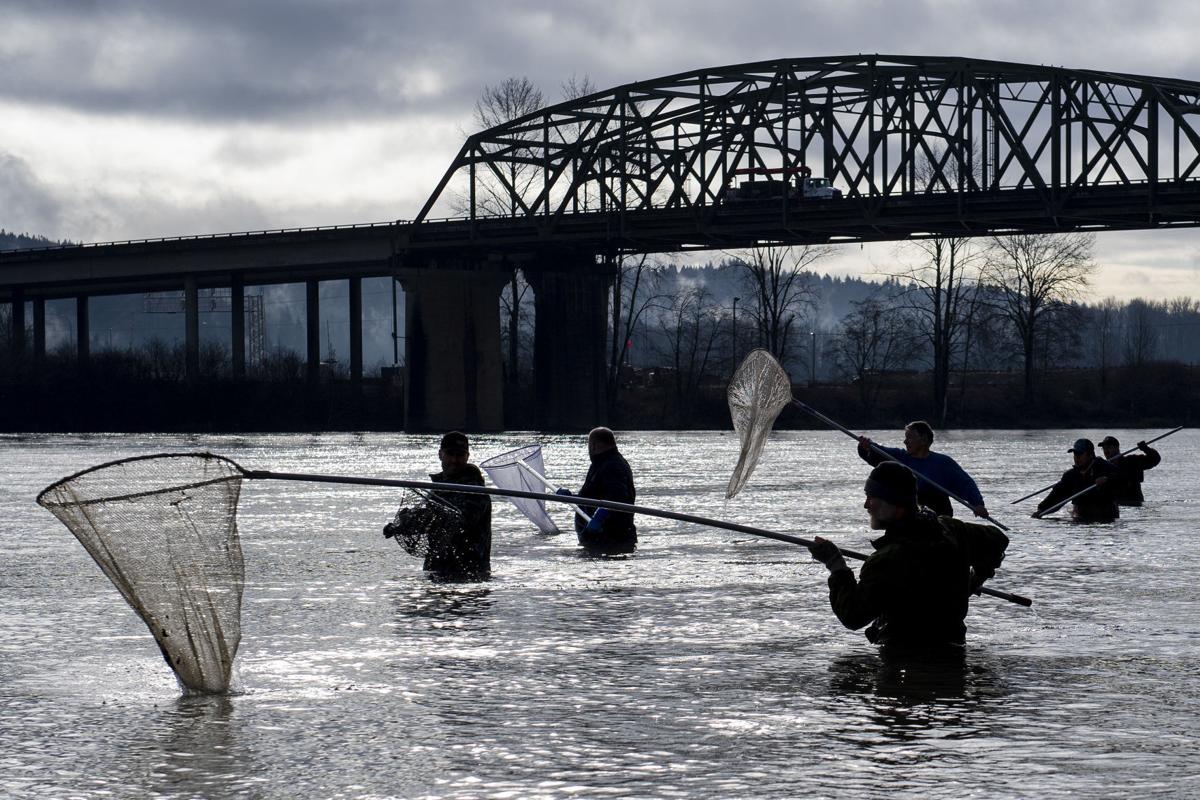
Smelt dippers are silhouetted waist deep in the Cowlitz River near Gerhart Gardens Park in Longview, Wash. during the one-day recreational season Feb. 14, 2020.
Although 40 years have passed since the eruption of Mount St. Helens devastated the Lower Columbia Region in a landmark geological event, Cowlitz County continues to feel the effects, both literal and symbolic, of the blast.
In a year of another lifechanging crisis, the COVID-19 pandemic, the Daily News top five environmental stories fittingly cover fish, fires and two developments in the ongoing response to sediment and flooding woes that are a consequence of the 1980 eruption.
The year opened on a light night for smelt dippers, who received the approval to dip for the thin silvery fish for the first time since 2017. The recreational fishery opened on Valentine’s Day, long before most Cowlitz County residents had heard of the novel coronavirus.
Hundreds of people lined the bank of the Cowlitz River for their chance to net up to 10 pounds of fish. And smelt runs proved strong enough for Washington State Fish and Wildlife to open a second round for sport dippers a week later.
Washington State Fish and Wildlife later in the year updated its salmon fishing policies for the Columbia River to reintroduce gillnets to the main stem of the river. Sport anglers reeled at the apparent reversal of plans to prohibit the controversial gear, while commercial fishers praised the chance to return to traditional methods of fishing.
The agency also opened a seven-day razor clam dig in September that drew thousands of diggers. Additional digs were canceled due to high levels of domoic acid, a toxin that is not safe for human consumption in large doses.
Talk of fish also featured in number of developments in the decades-long conversation about whether to remove the four Lower Snake River Dams, which environmentalists say contribute to declining salmon and orca populations.
Among the most significant updates was the release of a final environmental impact statement reviewing operations of 14 dams owned and operated by the U.S. Army Corps of Engineers, Bonneville Power Administration and Bureau of Reclamation. The study concluded that the dams, which include those on the Lower Snake, should stay in place. However, dam operators should continue to find ways to make the structures more fish friendly.
Ahead of the federal report, pro-hydropower groups commissioned their own studies to explore the cost of dam removal might cost in terms of lost energy and river commerce. And after the report came out, several conservation groups filed a lawsuit to challenge the findings.
Meanwhile, PacifiCorp and the Cowlitz PUD submitted an application to amend its operating license for three dams on the Lewis River to allow for cheaper fish recovery strategies. The move faced sharp criticism from native tribes and fish conservation groups that signed onto a Settlement Agreement to issue the licenses in the first place.
Like the ashy column that rose an estimated 12 to 15 miles into the air and darkened skies when Mount St. Helens when the volcano erupted, wildfire smoke from blazes all along the West Coast filled the air for most of September.
As COVID-19 made indoor spaces a risky place of potential viral spread, the smoky air also made outdoor spaces dangerous, with highly hazarous air quality.
The Big Hollow Fire in Gifford Pinchot National Force ignited closest to Cowlitz County, and Cougar residents were told to prepare to evacuate.
Fueled by a relatively dry summer, the fires sparked debate about climate change, forest management practices and politically based arson — though the last of these was proved largely unfounded by fire officials.
The region waited nearly two weeks with bated breath for a breeze and rain to clear the smoke and make the outdoors safe again.
(Ironcially, too much rain earlier in the year proved problematic when 50,000 cubic yards dirt and rock slid across State Route 4 nine miles west of Cathlamet, temporarily closing the road.)
And then there was the 40th anniversary of the Mount St. Helens eruption. The pandemic canceled most of the activities and events to honor the blast, while others moved online to a digital format.
TDN caught up with multiple scientists studying the volcano — and preparing to pass on their work. And other TDN articles commemorated the eruption more symbolically, by detailing the ongoing work to avoid potential flooding consequence of sediment and debris dumped by the lateral blast.
A month ahead of the anniversary, the U.S. Forest Service officially proposed building a 3.4-mile access road to facilitate repairs of the Spirit Lake tunnel. Scientists and conservationists oppose the plan because they worry the road could trash research plots on the pumice plain, one of the most heavily researched lanscapes on the planet.
The project focuses primarily on repairing the 35-year-old tunnel that prevents catastrophic flooding in the Cowlitz and Toutle river valleys by draining water from Spirit Lake, which had its historic outflow points otherwise blocked by debris from the 1980 explosion.
Mount St. Helens-related flooding came up again in pages of the Daily News when the federal government funded the Army Corps to monitor sediment in the Lower Cowlitz River.
In the past, the Corps had not gotten its requested money to monitor the amount of sediment still sluicing off Mount St. Helens into local waterways, even though the buildup presents flooding danger to downstream communities. The lack of funding forced Cowlitz County, the City of Castle Rock, and the Longview, Kelso and Lexington diking districts in 2019 to pay the Corps $110,000 to survey the river for the first time in four years.
Subscribe to our Daily Headlines newsletter.
December 20, 2020 at 07:00PM
https://ift.tt/37zUnCI
2020, The Pandemic Year: Fish, fire and MSH's 40th, the top five environmental stories of the year - Longview Daily News
https://ift.tt/35JkYuc
Fish
No comments:
Post a Comment